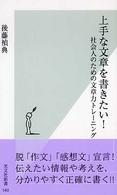- ホーム
- > 洋書
- > 英文書
- > Science / Mathematics
Full Description
Tribocorrosion causes the degradation or alteration of materials through the combined action of corrosion and wear. It limits the performance and life-time of installations, machines and devices with moving parts, and controls certain manufacturing processes such as chemical-mechanical polishing. The effects of tribocorrosion are most pronounced on passive metals which owe their corrosion resistance to a thin protecting oxide film. Most corrosion-resistant engineering alloys belong to this category.This book provides an introduction to the developing field of tribocorrosion and an overview of the latest research. Part one reviews basic notions of corrosion and tribology, before presenting the most recent results on the growth and structure of passive oxide films. Tribocorrosion mechanisms under fretting, sliding and erosion conditions, respectively, are then discussed. Part two focuses on methods for measuring and preventing tribocorrosion. It includes chapters on electrochemical techniques, the design of tribocorrosion test equipment, data evaluation and the optimisation of materials' properties for tribocorrosion systems. Part three presents a selection of tribocorrosion problems in engineering and medicine. Three chapters address the tribocorrosion of medical implants including test methods and clinical implications. Other chapters examine tribocorrosion issues in nuclear power plants, marine environments, automotive cooling circuits, elevated-temperature metal working and chemical-mechanical polishing.With its distinguished editors and international team of expert contributors Tribocorrosion of passive metals and coatings is an invaluable reference tool for engineers and researchers in industry and academia confronted with tribocorrosion problems.
Contents
Contributor contact detailsIntroductionPart I: Fundamentals of tribocorrosionChapter 1: Corrosion and passivity of metals and coatingsAbstract:1.1 Introduction1.2 Thermodynamics of electrochemical corrosion reactions1.3 Kinetics of electrochemical corrosion reactions1.4 Passivity of metals and alloys1.5 Special modes of corrosion of passive metals and alloys1.6 A short description of the physicochemical principles of corrosion protection1.7 Future trends and challengesChapter 2: Adsorption layers and passive oxide films on metalsAbstract:2.1 Introduction2.2 Dissolution in the active state and effect of adsorption layers2.3 Growth of two-dimensional (2D) passive layers2.4 Structure and composition of three-dimensional (3D) passive films on metals and alloys2.5 ConclusionChapter 3: Friction and wear of passive metals and coatingsAbstract:3.1 Introduction3.2 Friction3.3 Wear3.4 Indices of severity of contact and wear maps3.5 Representative experimental values of specific wear rates ws and wear coefficients K3.6 Discussion3.7 ConclusionsChapter 4: Environmental effects in frettingAbstract:4.1 Introduction and definitions4.2 Basics of fretting4.3 Environmental effects in tribology4.4 Environmental effects in fretting4.5 Some examples of fretting behavior4.6 ConclusionChapter 5: Tribocorrosion mechanisms in sliding contactsAbstract:5.1 Introduction5.2 Basis and mechanisms5.3 Tribocorrosion mechanisms5.4 Modelling in tribocorrosion5.5 Future challengesChapter 6: Models and mechanisms of erosionaEURO"corrosion in metalsAbstract:6.1 Introduction6.2 Erosion6.3 Erosion-corrosion models6.4 Erosion-corrosion maps for particulate metal matrix composites6.5 Erosion-corrosion maps: 3D6.6 Erosion-corrosion maps based on experimental data6.7 Conclusions6.9 Appendix: nomenclaturePart II: Methods for measurement and prevention of tribocorrosionChapter 7: Electrochemical methods in tribocorrosionAbstract:7.1 Introduction7.2 Electrochemical techniques in corrosion7.3 Electrochemical techniques: from electrochemistry to triboelectrochemistry7.4 Tribology as a protagonist in electrochemistry7.5 Instrumental aspects7.6 Applications of electrochemical techniques: a literature survey7.7 Quantitative approaches to tribocorrosion using electrochemical techniques7.8 Advanced electrochemical techniques in tribocorrosion7.9 Trends and perspectivesChapter 8: Tribocorrosion test protocols for sliding contactsAbstract:8.1 Introduction8.2 Tribocorrosion rigs for sliding contacts8.3 Tribocorrosion protocols8.4 ConclusionsChapter 9: Methods for studying erosionaEURO"corrosionAbstract:9.1 Introduction9.2 The role of testing/impact parameters on erosion-corrosion testing9.3 Methods for the study of slurry erosion - corrosion9.4 High temperature erosion-corrosion9.5 ConclusionsChapter 10: Metallic materials for tribocorrosion systemsAbstract:10.1 Introduction10.2 Material properties resistant to corrosion and wear10.3 Tribocorrosion and particular materials10.4 Surface modifications10.5 Future trendsChapter 11: Coatings for tribocorrosion protectionAbstract:11.1 Introduction11.2 Tribocorrosion behaviour of coatings11.3 Examples of tribocorrosion coatings11.4 ConclusionsPart III: Tribocorrosion in engineering and medicineChapter 12: Biotribocorrosion: surface interactions in total joint replacement (TJR)Abstract:12.1 Introduction12.2 Total joint replacement (TJR): development and evolution12.3 Corrosion of metallic biomaterials12.4 Tribology behaviour of metal-on-metal total joint replacement (MoM TJR)12.5 Protein effects12.6 Contact angle12.7 ConclusionsChapter 13: Tribocorrosion in artificial joints: in vitro testing and clinical implicationsAbstract:13.1 Introduction13.2 Clinical implications of tribocorrosion13.3 Tribocorrosion research in biomedical applications13.4 Test conditions and protocol for the evaluation of biomedical implants13.5 Case study: tribocorrosion of CoCrMo alloy in self-mating hip joint13.6 ConclusionsChapter 14: Fretting corrosion in biomedical implantsAbstract:14.1 Introduction14.2 Fretting corrosion of biomaterials in the human body14.3 Understanding fretting corrosion and its parameters14.4 Fretting corrosion of biomaterials14.5 Conclusions and future trends14.6 AcknowledgementsChapter 15: Tribocorrosion issues in nuclear power generationAbstract:15.1 Introduction15.2 Wear of nuclear components15.3 Methodology15.4 Parametric tribometers 'AURORE'15.5 Main experimental results15.6 ConclusionsChapter 16: Tribocorrosion in marine environmentsAbstract:16.1 Introduction16.2 Tribocorrosion applications in marine engineering16.3 Failure analysis of hydraulic cylinder piston rods used in riser tensioning systems16.4 Factors affecting tribocorrosion in marine environments16.5 Testing and material qualification16.6 Conclusions and future trends16.8 Appendix: abbreviationsChapter 17: Erosion-accelerated corrosion in flow systems: the behavior of aluminum alloys in automotive cooling systemsAbstract:17.1 Introduction17.2 Basics of erosion-corrosion (E-C) of metals17.3 Erosion-corrosion (E-C) of aluminum alloy in automotive cooling system17.4 Perspective on erosion-corrosion (E-C) research in flow systems17.5 ConclusionsChapter 18: Chemical-mechanical polishing (CMP): a controlled tribocorrosion processAbstract:18.1 Introduction18.2 Chemical-mechanical polishing (CMP) configuration18.3 Effects of friction on material removal18.4 Electrochemical and mechanical wear in chemical-mechanical polishing (CMP)18.5 Conclusions18.6 AcknowledgementsChapter 19: Tribocorrosion at elevated temperatures in the metal working industryAbstract:19.1 Introduction19.2 Approaches for the prevention of tribocorrosion at high temperature in the metal working industry19.3 Oxidation mechanisms for steel working tools19.4 Experimental study of high temperature wear and friction behavior19.5 Role of wear particles19.6 Conclusions and future trendsIndex






